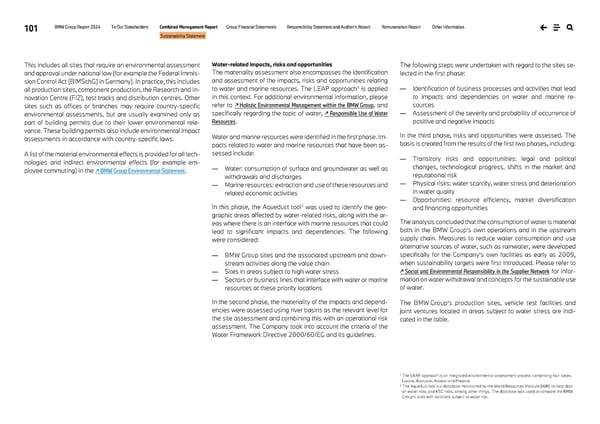101 BMW Group Report 2024 To Our Stakeholders Combined Management Report Group Financial Statements Responsibility Statement and Auditor’s Report Remuneration Report Other Information Sustainability Statement This includes all sites that require an environmental assessment and approval under national law (for example the Federal Immis- sion Control Act [BIMSchG] in Germany). In practice, this includes all production sites, component production, the Research and In- novation Centre (FIZ), test tracks and distribution centres. Other sites such as offices or branches may require country-specific environmental assessments, but are usually examined only as part of building permits due to their lower environmental rele- vance. These building permits also include environmental impact assessments in accordance with country-specific laws. A list of the material environmental effects is provided for all tech- nologies and indirect environmental effects (for example em- ployee commuting) in the ↗ BMW Group Environmental Statement. Water-related impacts, risks and opportunities The materiality assessment also encompasses the identification and assessment of the impacts, risks and opportunities relating to water and marine resources. The LEAP approach1 is applied in this context. For additional environmental information, please refer to ↗ Holistic Environmental Management within the BMW Group, and specifically regarding the topic of water, ↗ Responsible Use of Water Resources. Water and marine resources were identified in the first phase. Im- pacts related to water and marine resources that have been as- sessed include: — Water: consumption of surface and groundwater as well as withdrawals and discharges — Marine resources: extraction and use of these resources and related economic activities In this phase, the Aqueduct tool2 was used to identify the geo- graphic areas affected by water-related risks, along with the ar- eas where there is an interface with marine resources that could lead to significant impacts and dependencies. The following were considered: — BMW Group sites and the associated upstream and down- stream activities along the value chain — Sites in areas subject to high water stress — Sectors or business lines that interface with water or marine resources at these priority locations In the second phase, the materiality of the impacts and depend- encies were assessed using river basins as the relevant level for the site assessment and combining this with an operational risk assessment. The Company took into account the criteria of the Water Framework Directive 2000/60/EG and its guidelines. The following steps were undertaken with regard to the sites se- lected in the first phase: — Identification of business processes and activities that lead to impacts and dependencies on water and marine re- sources — Assessment of the severity and probability of occurrence of positive and negative impacts In the third phase, risks and opportunities were assessed. The basis is created from the results of the first two phases, including: — Transitory risks and opportunities: legal and political changes, technological progress, shifts in the market and reputational risk — Physical risks: water scarcity, water stress and deterioration in water quality — Opportunities: resource efficiency, market diversification and financing opportunities The analysis concluded that the consumption of water is material both in the BMW Group’s own operations and in the upstream supply chain. Measures to reduce water consumption and use alternative sources of water, such as rainwater, were developed specifically for the Company’s own facilities as early as 2009, when sustainability targets were first introduced. Please refer to ↗ Social and Environmental Responsibility in the Supplier Network for infor- mation on water withdrawal and concepts for the sustainable use of water. The BMW Group’s production sites, vehicle test facilities and joint ventures located in areas subject to water stress are indi- cated in the table. 1 The LEAP approach is an integrated environmental assessment process comprising four steps: Locate, Evaluate, Assess and Prepare. 2 The Aqueduct tool is a database maintained by the World Resources Institute (WIR) to map data on water risks and ESG risks, among other things. The database was used to compare the BMW Group’s sites with locations subject to water risk.
 BMW Group Report 2024 Page 100 Page 102
BMW Group Report 2024 Page 100 Page 102